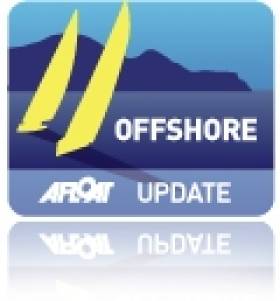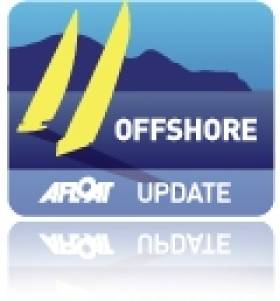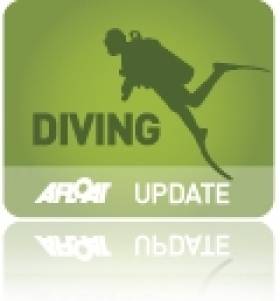Displaying items by tag: world record
Spindrift 2 Smashes Discovery Route Record
#WorldRecord - Six days, 14 hours, 29 minutes and 21 seconds: that's the new time to beat after the crew of Spindrift 2 smashed the previous Discovery route record by more than 20 hours.
The world's largest racing trimaran crossed the finish line at San Salvador in the Bahamas in the early hours of yesterday morning (6 November) after a blisteringly fast Atlantic crossing from Cadiz in Spain.
Reaching speeds of up to 46.08 knots and covering more than 714 miles last Friday 1 November alone, it was expected that the vessel skippered by Dona Bertarelli and Yann Guichard would make an impact.
But even rough seas and technical mishaps going into the final stretch didn't put much of a dent in their incredible margin, almost a full day ahead of the time set by previous record holder Groupama 3 in 2007.
And this amazing achievement will surely erase memories of Spindrift's woes in Dublin Bay over the summer.
"This is huge," said Bertarelli after confirmation of their record. "The emotion was waiting for us the moment we crossed the line. I enjoyed this race a lot; my first crossing of the Atlantic, in a race, for a record, with a good result at the end.
"Any doubts I might have had about this boat have gone. It is an extraordinary machine, and was combined with a great crew, following superb preparation made by the team on the ground and a sound choice of route."
Spindrift 2 Enters Final Stretch Of Atlantic Record Attempt
#WorldRecord - Now on day six of their Discovery route record attempt, Dona Bertarelli and Yann Guichard's Spindrift 2 is on the home stretch as the aim to reach the Bahamas in the early hours of tomorrow morning (6 November).
After setting out from Cadiz in Spain last Thursday 31 October, the world's largest racing trimaran experienced her first major difficulties of the transatlantic challenge over the past 24 hours, losing significant pace in rough seas between two violent squalls and seeing her first mechanical failure of the voyage, though that was quickly resolved.
The boat managed an average of just 14.5 knots overnight to advance 175 miles, seeing their lead on the current record holder slip by 60 miles in a single day.
But co-skippers Bertarelli and Guichard and their experienced crew put so many miles in the bag earlier in the week that they still have a massive 270-mile lead on the old record, set in May 2007 - now an age away in terms of boat development.
And with a strong northerly breeze coming down the North American coastline towards the Bahamas, the last 600 miles of the race should see Spindrift 2 show her fullest potential as the 'F1 of the seas'.
"This last phase of the course looks like is going to be tough," admits Bertarelli, noting storms on the radar at the finish line, but Spindrift 2 "is a beast of a machine, her strength in the strong wind is phenomenal."
#Diving - An Irishman who set a world record for long-distance SCUBA diving is preparing to double that incredible feat.
Christopher Healy set the Guinness World Record for the fastest SCUBA dive over a distance of 10km in October 2011 in an effort to raise funds for the Share a Dream Foundation, which raised the spirits of his son Stephen when he was diagnosed with Non-Hodgkin's Lymphoma.
The experienced diving instructor - who runs the Atlantic Diving School in Co Clare - followed a long line of Irish divers such as Declan Devine, Sean McGahern and Paul Devane who've either smashed or attempted to smash records in the field.
And Healy has since written a book, The 10K Record, about the highs and lows of his journey to breaking the record.
But this weekend he aims to double that effort - and raise more funds for Share a Dream and Temple Street Children's Hospital - by SCUBA diving an unbroken 20km route in Lough Derg.
Staring at Mountshannon Harbour at 3am this Sunday 7 July, Healy will travel underwater towards Scariff and back via Scilly Island to Killaloe, aiming to arrive around 3pm.
He will be accompanied along the way by a small flotilla of support boats to replace his air supply and record his journey for verification.
For more about Healy's 20km diving challenge and how you can donate, visit the Facebook page HERE.
Surf Record Breaker Garrett McNamara Rides '100ft Wave'
#Surfing - Garrett McNamara has done it again - after riding what is claimed to be the largest wave ever surfed.
Last summer on Afloat.ie we reported that the Irish-American surfing pro had his previous world record attempt - a 78-foot monster off Portugal in November 2011 - confirmed by Guinness record-keepers.
But the Hawaiian wasn't content to rest on his laurels, and on a recent return visit to Nazaré he is said to have smashed his own record with a wave reported to be as much as 100ft in height.
The Guardian has video of McNamara's incredible attempt which you can view below - it's a sight that beggars belief!
McNamara's previous tow-in surf at Nazaré earned him the Biggest Wave title at the 2012 Billabong XXL Big Wave Awards. He shared his $15,000 prize money with Devon surfer Andrew 'Cotty' Cotton, who towed him by personal watercraft into the massive swell.
"Everything was perfect, the weather, the waves," said Northern Irish surfer Al Mennie, who was on hand to witness the pair at Praia do Norte.
Sailrocket Speed Sailing Records Confirmed
#SPEED - The World Speed Sailing Records Council has confirmed two new world records set by Paul Larsen's Vestas Sailrocket 2 last month.
As previously reported on Afloat.ie, the Weymouth-based sailor and his crew claimed an average speed over over 59 knots with a peak of 63.5 knots on the 500-metre run on Namibia's Skeleton Coast using the purposely designed hydrofoil.
Their speed smashes the previous record of 55.65 knots set by kitesurfer Rob Douglas in the 2010 Luderitz Speed Challenge.
But not content to rest on their laurels, two days later they did it again - raising the bar for the fastest nautical mile along the same stretch of coastline by more than 5 knots, and taking the accolade held by Alain Thébault's Hydroptère since 2009.
For Larsen, the confirmation is vindication for more than a decade spent chasing 'the perfect reach'.
#ANGLING - Welsh angler Ceri Jones couldn't believe his luck when he fished a record-breaking monster trout from Lough Corrib last weekend.
According to The Connacht Telegraph, Jones hooked the 24lb goliath near the lake's biggest island Inishgoll on Saturday 26 May.
And if declared an authentic specimen by the Irish Specimen Trout Committee, it will rank as the largest trout caught in Ireland since 1894, when William Mears landed a 26lb brown trout at Lough Ennell.
Jones, a freelance photographer with Trout Fisherman magazine, said: “When I hooked it first, I knew instantly it was big fish. It was like hooking a car, the line just streamed off the reel.
“Using this type of big bait, you're either going to get nothing or a big fish,” he added, referring to the roach deadbeat he used to troll the trout for over an hour.
The Welshman plans to have his prize stuffed and mounted in Burke's Bar in Clonbur, Co Galway.
The Connacht Telegraph has more on the story HERE.
#SURFING - It's official - an Irish-American surf pro did indeed ride the world's biggest wave, and will have his name in the Guinness Book of Records to prove it.
Record-keepers have confirmed that a 78-foot monster wave caught by Garrett McNamara off Portugal last November is the biggest ever surfed, according to BBC News.
As previously reported on Afloat.ie, the offshore area at Praia do Norte, off Nazaré, is noted for its deepwater canyon that channels massive swells from the Atlantic.
The tow-in surf also earned McNamara the Biggest Wave title at the 2012 Billabong XXL Big Wave Awards, the winners of which were announced this week.
Devon surfer Andrew 'Cotty' Cotton earned half a share of McNamara's $15,000 prize money as the one who towed him by personal watercraft into the massive swell.
"I feel so stoked for him, it was an amazing achievement," said Cotty, a fellow nominee for the Biggest Wave award - along with Ireland's Ollie O'Flaherty - for his efforts off Mullaghmore Head in March this year.
"Everything was perfect, the weather, the waves," said Northern Irish surfer Al Mennie, who was tow-in surfing with McNamara and Cotty when the giant swell arose at Praia do Norte.
“As I rode this wave, it seemed pretty massive, but I couldn’t tell quite how big it was,” McNamara told surf forecast site Surfline at the time. “When I got to the bottom and turned and got around the wave and went to kick out, it landed on me and it felt like a ton of bricks.
"Probably one of the most powerful waves ever to land on me at the shoulder," he added. "It was pretty amazing.”
World Record Attempt by Irish-Raised Diver
#DIVING - Deep sea diver Sean McGahern is currently attempting the world record for cold water open sea diving in Malta.
The Times of Malta reports that McGahern - who was born in England but raised in Ireland before moving to Malta 17 years ago - entered the water at the Starfish Diving School before midnight last night, hoping to break the standing record of 11 hours and 46 minutes.
His previous attempt at the record was ended little more than an hour short of the record due to bad weather, but today's clear forecast has buoyed his confidence.
McGahern plans to pass the time by cleaning the seabed, assisted by a team of 16 safety divers, but he also intended to catch some sleep below the depths.
“I’ve slept underwater before," he said. "it’s not as difficult as you might think.”
McGahern, who previously held the warm water open sea dive record, is undertaking the challenge for Dar tal-Providenza, a home for the disabled on the Mediterranean island.
Dutch Teen Breaks Record for Youngest Solo Round-The World Voyage
#WORLD RECORD - A Dutch teenager has become the youngest sailor to circumnavigate the world solo - following a court battle for the right to embark on the challenge.
Sixteen-year-old Laura Dekker sailed into harbour at Sint Maarten in the Caribbean on Saturday afternoon to complete her round-the-world voyage.
She arrived a year and two days after setting out, and beat the previous unofficial record held by Australian Jessica Watson by eight months, according to RTÉ News.
The feat is more remarkable in that Dekker sailed from port-to-port, staying at sea for at most three weeks at a time, whereas Watson voyaged non-stop.
But the adventure almost didn't happen, as Dekker and her father had to fight in a court in Utrecht for the right to attempt the record, as previously reported on Afloat.ie.
Dekker has originally planned to set out a year earlier, at the age of 14, but the court ordered her placed in the care of welfare officers on the grounds that she was too young to guarantee her safety at sea.
She finally won the court battle in July 2010 and set sail from Gibraltar the following month, though a change to her planned course saw the challenge officially begin in Sint Maarten in January 2011 instead.
However, the record will not be officially recognised by the Guinness Book of World Records nor the World Sailing Speed Record Council, which does not classify records by age.
RTÉ News has more on the story HERE.
Banque Populaire V Takes Jules Verne Trophy, Smashing World Record
#WORLD RECORD - France's Banque Populaire V has smashed the record for the fastest yacht sailing around the world, shaving nearly three days off the previous best.
BBC News reports that the yacht's 14-man crew crossed the line at 45 days, 13 hours, 42 minutes and 53 seconds to claim the Jules Verne Trophy - knocking 2 days, 18 hours, 1 minute and 59 seconds off the standing world record set by Groupama 3 nearly two years ago.
The 40-metre trimaran, which last year also set a record time in the gruelling Fastnet Race, raced around the globe with an average speed of 26.5 knots.
And the Loïck Peyron-skippered yacht would have beaten the challenge even sooner had it not been delayed for almost two days due to bad weather.
"It was an amazing feeling crossing the line," said crew member Brian Thompson in an audio interview with sailor Hannah White.
Franck Cammas, skipper of Groupama 3 and currently competing in the Volvo Ocean Race, also offered his congratulations to the Banque Populaire team.
"Obviously it's a superb performance as it's always complicated to sail around the world," he told Sail World. "Aboard boats which go so fast, you have to know how to keep pace and drive them at the right speed so as not to break them.
"The crew of Banque Populaire knew how to do it and they did a fine job."







































































